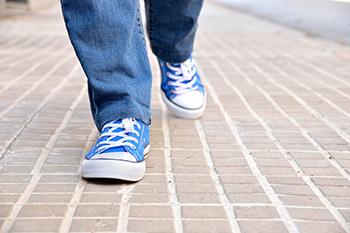Foot Shuffling
Tuesday, 20 June 2023 00:00
Foot shuffling is when someone takes shorter strides and drags their feet when walking. Consistent shuffling can be a sign of an underlying health issue related to the nervous system, joints, or muscles. The most common neurological condition causing a shuffling gait is Parkinson’s disease. Foot shuffling can also come on from foot drop. This is when there is a difficulty or inability to lift the foot while taking a step. This condition can be caused by multiple sclerosis, peripheral neuropathy, or stroke, among other things. As one ages, the gait can change with decreased walking speed and range of motion in the ankles, knees, and hips, as well as impaired foot clearance. When the joints of the legs are tight or there is muscle weakness from injuries, health conditions like arthritis, or long periods of inactivity, a shuffling gait can also happen. Stretching and strengthening exercises, balancing activities, and orthotics can help, as well as assistive devices like a walker or cane. If you have a shuffling gait, it is strongly suggested that you see a podiatrist to help identify the underlying cause and devise an appropriate treatment plan individualized to your needs.
If you have any concerns about your feet, contact Dawn Miles, DPM from Florida. Our doctor can provide the care you need to keep you pain-free and on your feet.
Biomechanics in Podiatry
Podiatric biomechanics is a particular sector of specialty podiatry with licensed practitioners who are trained to diagnose and treat conditions affecting the foot, ankle and lower leg. Biomechanics deals with the forces that act against the body, causing an interference with the biological structures. It focuses on the movement of the ankle, the foot and the forces that interact with them.
A History of Biomechanics
- Biomechanics dates back to the BC era in Egypt where evidence of professional foot care has been recorded.
- In 1974, biomechanics gained a higher profile from the studies of Merton Root, who claimed that by changing or controlling the forces between the ankle and the foot, corrections or conditions could be implemented to gain strength and coordination in the area.
Modern technological improvements are based on past theories and therapeutic processes that provide a better understanding of podiatric concepts for biomechanics. Computers can provide accurate information about the forces and patterns of the feet and lower legs.
Understanding biomechanics of the feet can help improve and eliminate pain, stopping further stress to the foot.
If you have any questions please feel free to contact one of our offices located in Palatka and Saint Augustine, FL . We offer the newest diagnostic and treatment technologies for all your foot and ankle needs.









